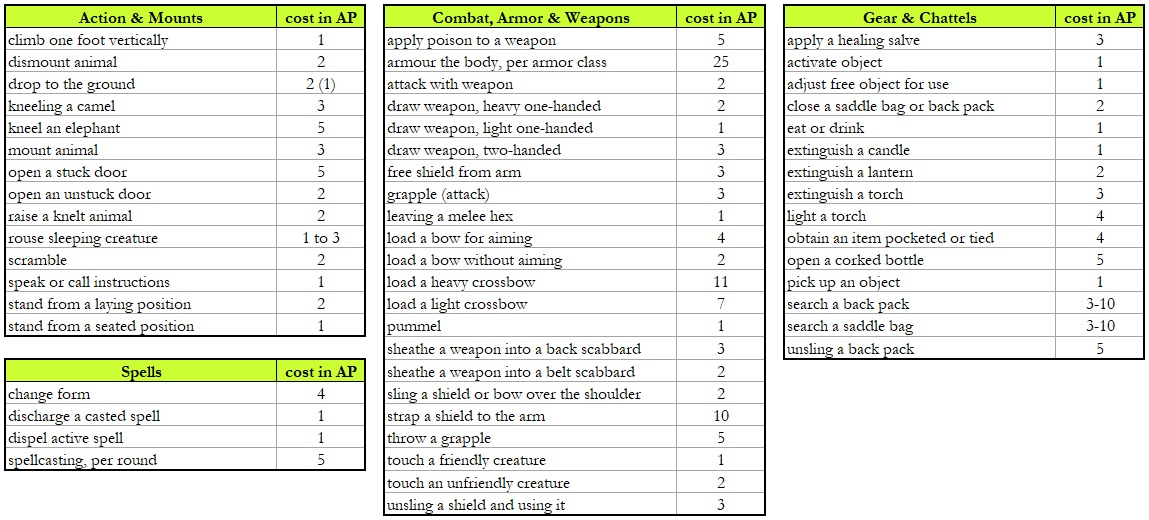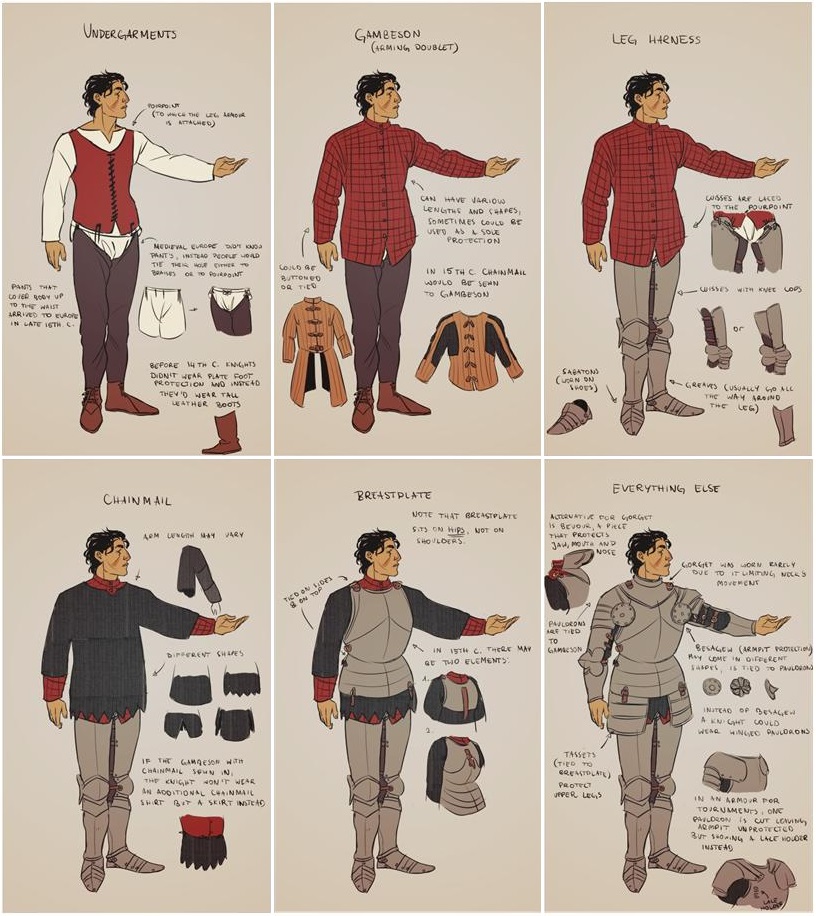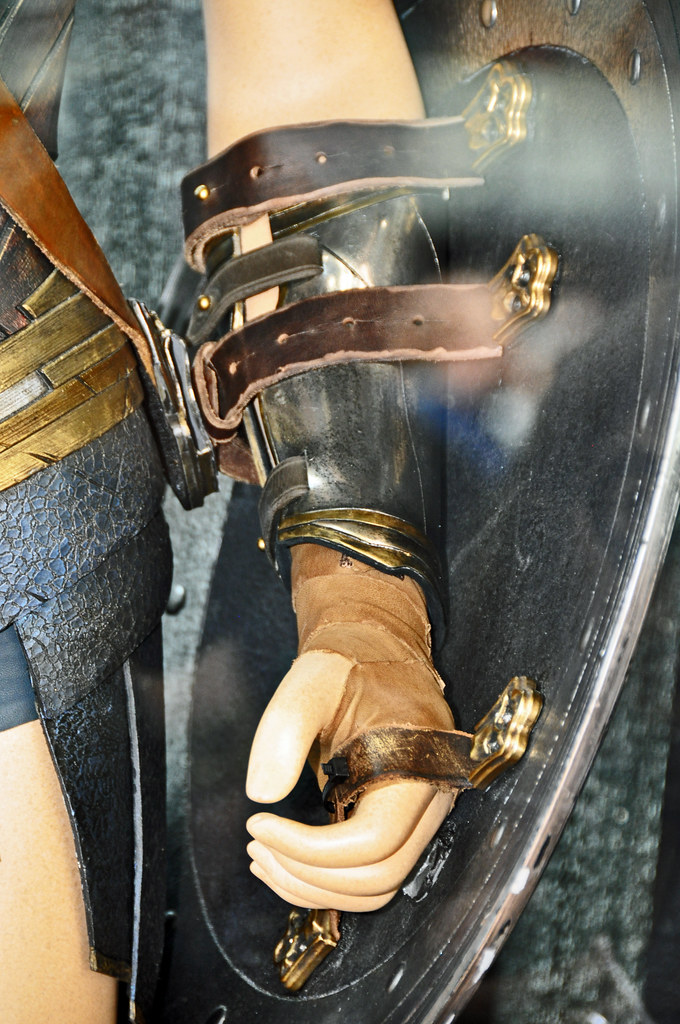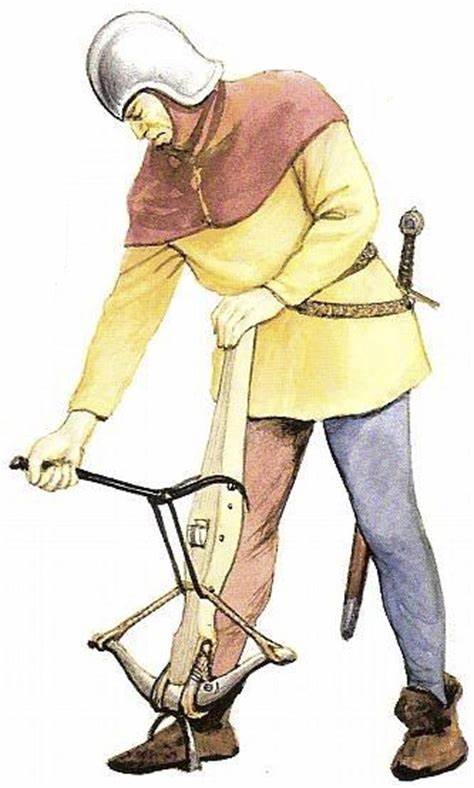Action Points
An action point, abbreviated as “AP,” describes a non-specific length of time within a combat round (12 seconds in length). The time is non-specific because different creatures moving at different rates of speed are nevertheless measured in the number of actions they can accomplish in the same period of time.
Action points, therefore, obliviate the need to keep time within the game. Creature actions are each assigned a “cost” in AP. In game terms, this requires the character or creature to make decisions regarding the best way to spend their total points — whether in attacking, moving or the performance of other tasks.
Action points that are not spent in the course of a combat round cannot be saved up and used later. Some actions do require more than one round to perform, such as casting a spell, loading a crossbow or searching for something. Such cases are clearly outlined in the notes below and follow conditions specific to their goals, being different in nature.
Movement
Strictly speaking, all actions are a form of movement; however, in game terms, the word “movement” refers specifically to the travel of persons from one combat hex to another, almost always relevant only during combat. A normal pace describes standard movement, in which 1 AP equals 1 hex of distance. Running describes movement at ½ AP per hex. Sprinting describes ⅓ AP per hex.
Some creatures also receive movement rates where AP costs are less than 1 per hex. The horse has a number of different gaits with differing AP costs per hex. The cheetah, for example, is able to move 40 hexes at a cost of two AP, when putting on a burst of speed. Various other creatures are also able to employ similar reductions in AP cost per hex.
Fast and large creatures throughout the bestiary usually begin with more action points than player characters.
Humanoid Movement & Encumbrance
The majority of humanoids, and therefore player characters, begin with 5 action points. Some, such as monks, because they are unusually fast, start with 6 AP. Some humanoids, such as kobalds that are very small, have only 4 AP. All player characters with the exception of monks, regardless of race, are considered to have 5 AP.
This total is adjusted by encumbrance, which is the measure of total gear and other weight carried along with the player. The amount of weight carried is optional; but it is possible that so much weight is added to the character that AP are reduced to zero. At that point, the player must drop something in order to move.
Point Costs
| Actions | AP Cost |
|---|---|
| climbing (per vertical foot) | 1 |
| dismount camel (by kneeling) | 3 |
| dismount horse, mule or donkey | 2 |
| drop to a prone position | 2 (1) |
The table below gives the cost in AP for choices the players and enemies may take. Obviously, the table is not all inclusive. It should be used as a guideline, with additional examples added when they present themselves.
Any action that requires 5 AP or less can be performed in a single combat round even though it requires more than a character’s total AP. This counts as the “full movement” of the character and costs all their AP.
For example, Albert the cleric has 3 AP; using his full movement rate, he is still able to awaken himself, mount an animal, cast a spell or apply poison to a weapon in a single combat round. He would, however, still need 7 full AP to load a light crossbow, spread over three rounds.
Table Notes
Many of these actions have exceptions and considerations that must be considered when managed as a DM. The subjects are listed alphabetically
Activate Object: includes any object, many of which will be magical in nature, that must somehow be turned on, commanded to act or otherwise activated. Includes uncorking a previously uncorked bottle or employing a wand, staff, rod, ring or similar item. The action will only turn the object “on.” The time listed does not include the time necessary for the object to start up, reshape itself, gather power or otherwise reach its peak of performance.
Adjust Free Object for Use: includes any object that, once grabbed or picked up, still needs to be turned or righted before it can be used, such as a shield, eyeglass, compass, lantern and so on. Does not include crossbows.
This includes adjusting the illumination or shutter on a lantern.
Apply a Healing Salve: the time given presumes that a healing salve is poured into a wound, so that its substance will be drawn into the body. If no wound exists, the time needed to enable the subject to swallow the healing salve is twice normal eating time (see below), or 4 AP. If the subject is unconscious, it requires two full combat rounds to introduce a healing salve.
Apply Poison to Weapon: before poison or any other substance can be applied to a blade for use, both the weapon and the substance must already be in hand. Includes applying substances to other items, such as oiling a rope, spreading glue, applying gripcolle or taking like action over a similar-sized surface.
Armour the Body: gives the time frame needed for suiting up in hauberk & chausses, [gorgets], breast plates, chain shirts, [tassets] and so on.
Regardless of the type of armour, each 25 AP spent increases the subject’s armour class by one armour class (lowers AC by 1). Leather armour would therefore require 50 AP to completely ready, studded leather or ring mail 75 AP, scale mail 100 AP and so on.
Aid can be received from one or two attendants. One attendant will reduce the time needed to 15 AP per point of AC while using two attendants will reduce the time needed to 10 AP per point of AC
Attack with Weapon: the time expended within a given round, in which the character is actively trying to hit an enemy.
If a combatant employs two weapons in their attack, each attack will cost 2 AP. Therefore, the character must have 4 AP available in order to attack with two weapons in a given round. If a character gains two attacks in a specific round due to level or other means, then each of those attacks will cost only 1 AP.
This cost also includes weapons that are hurled, which must be drawn at additional AP cost and be in hand before they are thrown. The same rule applies to weapons that are fired, which also have a cost of 2 AP. See attacking in combat.
Change Form: describes shape-change due to a spell, magical influence or inherent ability.
Climbing (per vertical foot): assumes the creature has no special climbing ability. Those with the sage abilities mountain climbing or tree climbing are able to climb at 1½ to 2 ft. per action point. Climbing down can be accomplished at double the speed needed to climb up.
Close a Saddle Bag or Back Pack: includes the time needed to close a buckle or draw string, to ensure that items are secured and won’t fall out. The AP indicated could also apply to locking a box, barring a door, tying closed a scroll case or a belt pouch, etcetera.
Discharge a Cast Spell: presumes the spell has been cast, and is now being released so as to cause effect. If a cast spell has not been discharged, the caster must continue to concentrate until the AP required by the spell is expended.
Dismount horse, mule or donkey: includes camels, donkeys, elephants, hippogriffs, horses, mules, pegasi and so on. Counts the time needed for dropping the reins and either stepping down or — with shorter characters — hopping clear of the animal and gaining balance for the next action. This number should be added to the process of kneeling a camel or an elephant, which must be done before the animal is dismounted.
Dispel Active Spell: describes only those spells which the caster has personally cast, and after the spell has been discharged. If the spell has been cast and not yet been discharged, there is no movement penalty for failing to discharge the spell, as it requires only breaking concentration.
Draw Weapon, Heavy One-handed: includes all weapons that may be used with one hand, weighing more than 5 lbs. List includes bastard sword, broad sword, hand axe, holy water sprinkler, long sword, mace and warhammer.
As some creatures with upper body strength can wield a normally two-handed weapon with one hand, for those persons this also includes the battle axe, military fork, military pick, spear and trident.
Draw weapon, Light One-handed: includes all weapons that may be used with one-hand, weighing less than 5 lbs. List includes ankus, bullwhip, club, dagger, dart, godentag, horseman’s flail, horseman’s mace, horseman’s pick, javelin, sabre, scimitar, short axe, short hammer, short sword, shiriken and throwing knife.
Draw weapon, Two-handed: includes all weapons that require two hands for use, regardless of weight. List includes battle axe, bola, bo stick, bow, corseque, crossbow, flail, glaive, great scimitar, guisarme, halberd, jo stick, khopesh, maul, military fork, military pick, morning star, pike, quarterstaff, sling, spear, staff sling, trident and two-handed sword.
Drop to a prone position: describes the time necessary to fall and take to the ground (1 AP) and then orient themselves to take further action (1 AP). If this action is employed with the character’s last action point in a given round, cost is only 1 AP.
Eat or Drink: shows AP cost per ounce of food or 2 ounces of fluid to be consumed. A potion consists of 8 ounces of fluid, and therefore requires 4 AP to consume. A healing salve consists of 2 ounces of edible material, therefore requiring 2 AP to eat.
Extinguish a Candle: describes the time needed, regardless of the method, to snuff a candle, either with the fingers, blowing it out or using a douser.
Extinguish a Lantern: includes the time needed to turn down the brightly burning lantern using a key. The lantern can be dimmed to half strength at a cost of 1 AP. A dimmed lantern can be turned off and extinguished entirely at 2 AP. A dimmed lantern will reduce its illumination.
Extinguish a Torch: presumes the torch cannot be doused in water, which requires only 1 AP. Otherwise, the torch must be stamped or struck out, strangled with a cloth or otherwise smothered.
Free Shield from Arm: describes situations where the shield has already been strapped to the arm of the combatant. Shields that are damaged from failing an item saving throw must be unstrapped or they will cause penalties to armour class. Time shown assumes the weapon is dropped (see sling a shield or bow, below).
Grapple (attack): the time necessary to physically wrestle with an opponent, in which the character is actively trying to hit an enemy.
Dismount camel (by kneeling): describes the process of settling the camel into a kneeling position, readying it to be dismounted or mounted.
Kneel an Elephant: describes the process of settling an elephant with a howdah into a kneeling position, so that the howdah can be entered or departed. Mounting or dismounting an elephant includes climbing a distance of four feet (see climbing, above).
Leave a Melee Hex: when engaged with an opponent in melee, defending against an enemy’s attack to back away, or circle the enemy, costs 1 AP in addition to the normal AP cost to move into the adjacent hex.
Light a Torch: presumes the torch and the means to light it are already in hand. If the torch is wet, it will require two full combat rounds to light using an open flame and cannot be lit at all using a tinder.
Load a Bow for Aiming: prepares a bow for firing next round. The length of time includes selecting an arrow, remaining situationally aware of the battlefield and judging the next target, something which improves for some character classes gain levels. Characters with multiple attacks in a round may halve the time just as they halve the AP necessary to attack.
Load a Bow without Aiming: describes cursory aiming with the weapon immediately after nocking and drawing the arrow. In this action, the bow can be fired once loaded, in the same round, but only if the character has sufficient AP to attack (see above). The penalty for firing a bow in this way is -2 to hit. Characters with multiple attacks in a round may halve the time just as they halve the AP necessary to attack.
Load a Heavy or Light Crossbow: describes a two-handed operation, with a sling for one foot to stand on to stabilize the weapon. Some crossbows may have a point that can be sunk into earth to stabilize it. The crossbow is then cranked until the drawstring is tight enough to fire. The weapon is then lifted and a bolt inserted into place for firing. The process requires 11 AP which may be spent in a steady action over three or more rounds. The weapon can be fired in the same round as the loading is completed with no penalty, but only if time for attacking is available.
Mount an Animal: Most animals are mounted with a single stirrup in which the rider puts their foot, hoisting themselves aboard. If the stirrup is higher than the diaphragm of the rider, the animal cannot be mounted in this fashion; either a step must be used, or the animal be made to kneel (see kneeling a camel or kneeling an elephant, above). Very large animals, such as an oliphant, must be climbed by rope ladder (the oliphant requires 9 feet of climbing).
The time given for mounting an animal is counted in addition to these other means, after kneeling the animal or the climb is accomplished, whether into a saddle or — in the case of an elephant or oliphant — a howdah. Climbing a step to a mounting position counts as 1 AP; the step will remain behind unless it is removed by another.
Obtain an Item Pocketed or Tied: describes items that are fixed to the character’s person (such as flasks, small blades, cricket cages, tawkra balls, etcetera) by straps, strings, hooks, or in pockets both outside and inside clothing. Obtaining access to these things usually requires shifting held objects, feeling for the object wanted, digging around under cloaks or through robes and being sure to grab the object firmly before pulling it free.
Open a Corked Bottle: describes a bottle that has never been previously opened.
Open an Unstuck Door: refers to the process of opening any ordinary door that is not barred, locked or otherwise restrained from its normal use. If the door is shouldered open (requiring a strength check), this requires but 2 AP. However, once the door is shouldered open, the person acting must make a dexterity check or tumble.
Open a Stuck Door: refers to doors that have swollen inside their frames, so that the pressure of the wood resists entry. Such doors are not opened by strength, but by force. The chance of opening said door equals the combined body mass of up to two persons, divided by 10, as a chance out of 100.
For example, two persons with a combined weight of 296 lbs. would have a 29 in 100 chance of forcing the door open, each round. Minimum time required is 2 AP, after which tumbling will occur. A failure indicates the remainder of that round’s action points are spent. Each round of attempt after the first will cause +1 damage, including attempts to crash through the door. Chance of success can be doubled if those attempting to force choose to run at the door, requiring a start two hexes away and automatically causing 1-6 damage from the crash.
Pick up an Object: includes bending over to retrieve an object from the ground or taking an object from any shelf or other location, for objects of 5 lbs. or less. Larger objects up to 8 lbs. will require 2 AP; up to 13 lbs. will require 3 AP; and up to 21 lbs. will require 4 AP.
Objects weighing up to 34 lbs., 55 lbs., 89 lbs., 144 lbs., 233 lbs. and so on will progressively require 1 additional AP per stage. This assumes humanoids weighing up to 233 lbs. For humanoids weighing progressively up to 377 lbs., 610 lbs., 987 lbs. and so on, subtract 1 AP from the cost of picking up each size class of item.
However, as size increases, it becomes progressively harder to pick up smaller items. And so, if the AP of an item is reduced to zero, instead add 1 AP to the time needed to collect that item. For example, a 350 pound humanoid bends down to pick up an item weighing less than 5 lb. Because the normal time is already 1 AP, this increases to 2 AP, while items between 5 lbs. and 8 lbs. reduces to only 1 AP (because this is the most comfortable size).
Pummel: the time necessary to attack with fisticuffs, in which the character is actively trying to hit an enemy.
Raise a Knelt Animal: describes the time needed to bring a camel or an elephant from its knees to a standing position, whether or not the animal is mounted. Mounted persons must ensure the animal is standing before forward movement is allowed.
Rouse Sleeping Creature: see rule for details. Light sleepers require 1 AP; normal sleepers 2 AP; and heavy sleepers 3 AP.
Scramble: describes the number of AP needed to move one combat hex over uneven ground, where the variation of surface is 11-30° upwards or downwards. This would include jumping onto a chair, a tree stump or upwards onto a short ledge that was, by angle, no higher than 30 degrees above the starting hex. A steeper climb, of 31-50°, requires 3 AP; a climb of 50-80° requires 4 AP; and any climb higher than 80 degrees is effectively climbing (see above).
Search a Back Pack: includes the process of opening, then digging through the contents of a back pack in search of a specific object. Anything that should be excessively obvious, due to size or nature, such as a rope or an immediately visible weapon, will require 3 AP. Any smaller object will randomly require 3-10 AP (d8+2). Time does not include the number of AP to close the bag after the object is found.
Search a Saddle Bag: similar to search a back pack, above. Character should make an wisdom check to see if they’ve remembered which of two saddle bags the item is located (or conversely, if they’ve wisely put the object where it belongs). A successful check will require only 2-4 AP. A failed check will require 3 AP of searching in the wrong bag, followed by 2-4 AP of searching in the right one. 1 AP is required for opening the bag.
Sheathe a Weapon into a Back or Belt Scabbard: time required regardless of the weight or nature of the weapon. The scabbard must, of course, be designed for the specific weapon in question.
Sling a Shield or Bow over the Shoulder: presumes that the shield has been freed from the arm and that the bow is strung. An unstrung bow is treated as sheathing a weapon into a back scabbard instead. A shield hook must be mounted on an over-the-shoulder belt to sling a shield on the person’s back.
Speak or Call Instructions: either limit the number of words that can be spoken to 4 words per AP, or 20 words per round, or use a time piece to measure the number of words that can be said in the time period reckoned. Speaking can be performed while performing any action that does not require strong attention (managing an animal, rousing a sleeper, searching) or using the mouth for other purposes (drinking, eating, spellcasting). See Parley & Negotiation.
Spellcasting: 1st and 2nd level spells usually require a full round to cast. As spells increase in power, they take more rounds to cast. Some spells, specifically not designed for the battlefield, may take hours to cast. Most cantrips take only a few action points in order to cast.
Stand from a Laying or Seated Position: includes the time necessary to adopt a fighting stance. Note that characters seated in a chair can, upon standing, seize the weapon as a club with only 1 additional AP. See Using Found Objects as Weapons.
Strap a Shield to the Arm: generally considered to require two complete rounds for an unarmoured person. Compare with the number of AP required for armouring the body. Strapping a shield can be aided by one other person, who will reduce the total time to 7 AP.
Throw a Grapple: describes the time necessary to ready the grapple, swinging it for momentum, hurling it outwards and testing the resistance of the grapple by pulling the rope taut. A failure requires the same amount of time.
Touch Friendly Creature: most often describes the delivery of a spell to a recipient. Supposes the person to be touched is ready and within reach (one combat hex) at the moment of touching, even reaching out towards the caster.
Touch Unfriendly Creature: most often describes an attempt by a caster to affect an unwilling enemy with a spell (cause light wounds, shocking grasp, etc.), who is most likely unaware that this is the intent of the caster. A miss should reveal this purpose to an intelligent creature, who would then give ground to avoid receiving the unknown spell’s effect (an attempt to pummel the creature might conceal this purpose).
Unsling a Back Pack: describes the time necessary to remove a back pack from its position between the shoulders of the combatant, whereupon it may be dropped. To search a back pack, see above.
Unsling a Shield: indicates the time needed to get the shield from the person’s back and into their hand, where it can be used for defence. Does not include the time necessary to strap a shield to the arm (see above).




